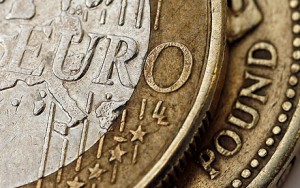 Yesterday’s trade saw EUR/GBP within the range of 0.7433-0.7513. The pair closed at 0.7489, up 0.48% on the day and a second consecutive daily gain.
Yesterday’s trade saw EUR/GBP within the range of 0.7433-0.7513. The pair closed at 0.7489, up 0.48% on the day and a second consecutive daily gain.
At 7:15 GMT today EUR/GBP was down 0.01% for the day to trade at 0.7455. The pair touched a daily low at 0.7442 at 6:00 GMT.
Fundamentals
Euro area
Spanish retail sales
Annualized retail sales in Spain probably rose at a pace of 1.25% in December, according to the median estimate by experts, following another 0.5% gain in November. If so, this would be the fastest annual rate of increase since November 2013 and also a fifth consecutive month of sales growth. This indicator reflects the change in the total value of inflation-adjusted sales by retailers in the country and provides key information regarding the consumer spending trend in a shorter term, while the latter is a key driving force behind economic growth. Companies, operating in the retail sector, provide monthly data regarding 4 main categories: food, personal equipment, household appliances and additional information in regard to other types of consumer goods. In case the retail sales index increased at a faster-than-expected pace, this would have a limited bullish effect on the euro. The National Institute of Statistics (INE) is expected to release the official report at 8:00 GMT.
German unemployment change
The number of the unemployed people in Germany probably dropped by 10 000 in January, according to the median forecast by experts, following a decrease by 27 000 during December. The latter has been the most significant monthly decline since January 2014, when the unemployed persons were 28 000 less. A decrease implies that consumer spending may be more active, while the latter is tightly related to economic growth. An increase suggests the opposite.
At the same time, the seasonally adjusted rate of unemployment in the country probably remained unchanged at 6.5% in January, according to expectations.
The seasonally adjusted harmonised jobless rate was steady at 5% for the ninth consecutive month in November. The number of unemployed persons dropped to 2.11 million in November from 2.12 million in October. The unemployment rate for people aged between 15 and 24 decreased to 7.4% in November from a revised 7.5% in the prior month.
In case the number of people unemployed decreased more than projected and the unemployment rate dropped, this would certainly support demand for the euro. The Federal Statistics Office will release the official data at 8:55 GMT.
ECB monthly report
At 9:00 GMT the European Central Bank will release its Monthly Report, including detailed analysis of current and future economic conditions and price stability risks in the Euro region from the bank’s perspective. It is usually published one week after the ECB’s interest rate decision.
Euro region Economic Sentiment Indicator
The final value of the consumer confidence index probably confirmed the preliminary reading of -8.5, which was reported on January 22nd. If so, this would be the highest level of confidence since July 2014, when the indicator stood at -8.4. The final index for December came in at -12.0, down from a preliminary estimate of -10.9. The indicator measures consumer confidence on a scale of -100 to +100. A reading of -100 suggests a lack of confidence, zero means neutrality and a reading of +100 indicates extreme levels of confidence. The index reflects the level of optimism, which consumers have about economic development in the region. The Business and Consumer Survey is conducted by phone and includes 23 000 households in the Euro zone. The questions asked stress on current economic and financial situation, savings intention and also on expected developments regarding consumer price indexes, general economic situation and major purchases of durable goods. This indicator is one of the five major components, that comprise the Economic Sentiment Indicator (ESI).
The ESI probably improved to 101.5 in January, according to expectations, from a reading of 100.8 in December. If so, this would be the highest level since July, when the index was reported at 102.1. The Economic Sentiment Indicator (ESI) is a composite indicator, consisting of five sectoral confidence indicators with different weights: Industrial confidence indicator, Services confidence indicator, Consumer confidence indicator, Construction confidence indicator and Retail trade confidence indicator. The ESI is calculated as an index with mean value of 100.0 and standard deviation of 10 over a fixed standardised sample period.
Higher confidence usually implies greater willingness to spend, including large-ticket purchases, while consumer spending is a key factor behind economic growth. Therefore, in case the ESI climbed more than anticipated, this would cause a certain bullish impact on the euro. The European Commission is expected to release the official ESI reading at 10:00 GMT.
German Consumer inflation – preliminary estimate
German preliminary annualized consumer inflation probably dropped to -0.1% during the current month, according to the median forecast by analysts, from a final rate of 0.2% in December. If so, this would be the first case with deflation since September 2009, when annual inflation was reported at -0.3%.
Decembers inflation rate was mainly influenced by falling prices of energy products. Energy costs dropped at an annualized rate of 6.6%. Prices were down for heating oil (-22.8%), motor fuels (-12.1%) and gas (-1.4%). Prices of electricity, however, climbed 1.9%. Additional downward pressure came from prices of food and non-alcoholic beverages, which fell 0.6% compared to December 2013, according to the report by Destatis.
The Consumer Price Index (CPI) presents a general picture of the price change in the country, while encompassing all household types, all regions and all goods and services demanded (food, clothing, automobiles, rental, repair and hairdressing services etc). The index is based on a basket of goods and services, which is regularly renewed, so that goods and services, purchased more often by consumers, are included in the present survey.
The nations preliminary annualized CPI, evaluated in accordance with the harmonized methodology, probably fell 0.2% in January, after a 0.1% rise in December. If so, this would be the lowest annual harmonized inflation since September 2009. The harmonized methodology is used for the sake of consumer inflation comparison in an international context (member-countries in the Euro area). In case the CPI disappointed expectations and further distanced from the 2-percent inflation objective, set by the European Central Bank, this would certainly mount selling pressure on the euro. Destatis is scheduled to publish the CPI report at 13:00 GMT.
Pivot Points
According to Binary Tribune’s daily analysis, the central pivot point for the pair is at 0.7478. In case EUR/GBP manages to breach the first resistance level at 0.7524, it will probably continue up to test 0.7558. In case the second key resistance is broken, the pair will probably attempt to advance to 0.7604.
If EUR/GBP manages to breach the first key support at 0.7444, it will probably continue to slide and test 0.7398. With this second key support broken, the movement to the downside will probably continue to 0.7364.
The mid-Pivot levels for today are as follows: M1 – 0.7381, M2 – 0.7421, M3 – 0.7461, M4 – 0.7501, M5 – 0.7541, M6 – 0.7581.
In weekly terms, the central pivot point is at 0.7539. The three key resistance levels are as follows: R1 – 0.7650, R2 – 0.7825, R3 – 0.7936. The three key support levels are: S1 – 0.7364, S2 – 0.7253, S3 – 0.7078.





